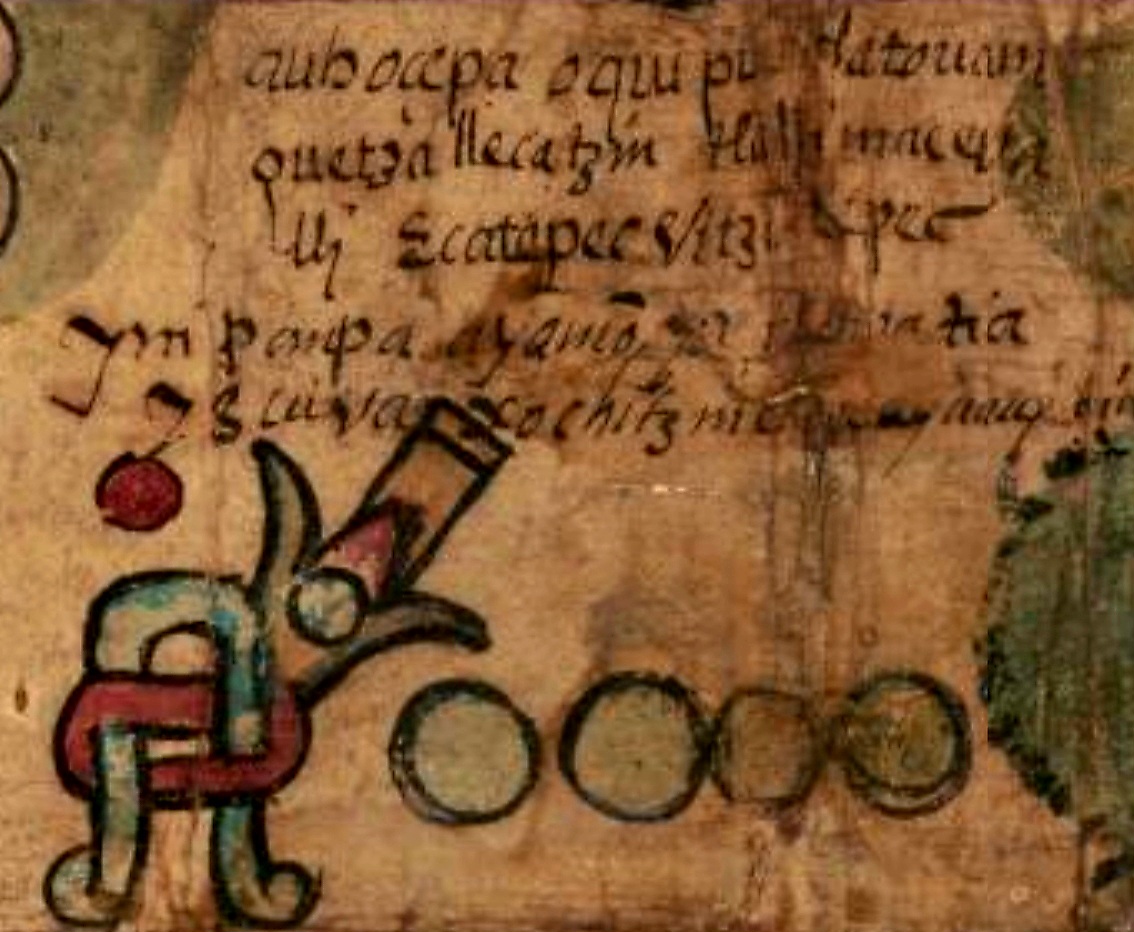Ce Acatl (CQ)
This combined notation and compound glyph represents the date One Reed (Ce Acatl). It has the Mixtec A-O year symbol with one red dot above it (notation for the number 1) and a reed (acatl) plant-based arrow sticking into the intersection of the A and the O. The A is turquoise blue, the color of many xihuitl year signs. The horizontal O is red. The reed arrow is yellow with green foliage, a turquoise circle, a small amount of yellow below the turquoise circle, and a red point above the circle.
A study of the Codex Quetzalecatzin made by Sebastián van Doesburg suggests that the year Two Reed (1443 C.E. in the Mixtec system) was when Quetzalecatzin became tlatoani (ruler; tlahtoani with the glottal stop) in Tecamachalco, and that in 1453 he began distributing lands (tlalli) and tributary laborers (macehualli) to various noble couples in the valley of Xochitlan. The various sources about this ruler conflict in the dates they recall. For instance, the Anales de Tecamachalco give One Rabbit as the date when Quetzalecatzin distributed lands to ancestors in Tecamachalco.
The year One Reed (1507) is also recalled as the date of activity of Quetzalecatzin's successor, Nahui Olintzin and his wife Atl. Furthermore, the next ruling couple, Nahua Xochitzin and his wife Tecpatl, governed for thirteen years beginning in the year One Reed. [See the citation for van Doesburg's study in our Bibliography, and see pp. 132–132.]
Stephanie Wood
Calendrics were an important element in the Nahuas' and Mixtecs' religious views of the cosmos. The A-O year glyph suggests a southern Puebla location for the towns mentioned in this manuscript, such as Huitziltepec, Todos Santos (Xochitlan), and Tochtepec (all located between Puebla and Tehuacan). The calendrical reed that is part arrow is also found in the Codex Mendoza, as shown below. Those acatl more clearly have feathers; in this one, perhaps the red pointed shape in the middle is a red feather? There are two Ce Acatl (One Reed) signs in this codex. The other one appears below.
Stephanie Wood
covers ruling men and women of Tecamachalco through 1593
Stephanie Wood
Two elements provide the literal reading of Ce Acatl, and the third, the A-O sign could be read "the year."
If we start with the A-O symbol, "the year," then go up to "one" and down to the "reed-arrow," then we are going upward and then downward.
reeds, canes, dates, years, calendars, calendarios, fechas, años, cañas, números, unos, xiuhpohualli, turquesa, xihuitl

ce, one, https://nahuatl.wired-humanities.org/content/ce
aca(tl), reed, reed-arrow, https://nahuatl.wired-humanities.org/content/acatl
Uno Caña, 1-Caña
Stephanie Wood
The Codex Quetzalecatzin, aka Mapa de Ecatepec-Huitziltepec, Codex Ehecatepec-Huitziltepec, or Charles Ratton Codex. Library of Congress. https://www.loc.gov/item/2017590521/
The Library of Congress, current custodian of this pictorial Mexican manuscript, hosts a digital version online. It is not copyright protected.






